Books by Tajana Sekelj Ivančan
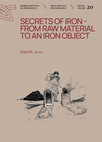
The International Scientific Conference entitled “Secrets of iron - from raw material to an iron ... more The International Scientific Conference entitled “Secrets of iron - from raw material to an iron object” was organized by the Institute of Archaeology in cooperation with the Archaeological Museum in Zagreb as the seventh in a series of meetings of experts on topics related to medieval archaeology, but also other archaeological and historical periods. The gathering took place in Zagreb on the 10th and 11th of September 2020 in the Gallery of the Archaeological Museum in Zagreb at 6 Pavao Hatz Street, with an all-day program. The Organizing and Scientific Committee consisted of scientists from the Institute dealing with the medieval period: Tajana Sekelj Ivančan, PhD. Tatjana Tkalčec, PhD. Juraj Belaj, PhD. Siniša Krznar PhD. and doctoral student Tena Karavidović. A total of 62 colleagues participated, of which 44 international and 18 Croatian, who presented 16 international and 11 local presentations and/or posters. Although we live in challenging and unstable times caused by the pandemic of Covid-19 virus, but also by the earthquake in Zagreb which, in the spring of 2020, significantly damaged the city centre, the intention to address issues related to iron production and the manufacture of iron objects in the pre-industrial era was successfully realised. The scientific conference was organized as a hybrid event, with presentations held at the Museum Gallery and via the web platform, all broadcasted live with the active involvement of participants in discussions through the web platform Crowdcast. Posters of the participants who were not able to attend the conference in person were printed out and available online on the Institute of Archaeology website during the conference. The official languages of the conference were Croatian and English. Several lectures and presentations from the conference were prepared for these Proceedings. The received papers cover multiple archaeological and historical periods, from the Early Iron Age up to the Modern Age, while geographically covering almost the entire European area and beyond. The Proceedings are interdisciplinary and include papers with various methodological approaches and sub-topics that permeate and complement each other. The sixteen papers collected in the publication present the results of non- invasive research methods on sites with remnants of ironworks activities, the geological study of the potential for ore formation within a lowland landscape, studies of ore sources and mining, the results of archaeological excavations of preserved furnaces, workshops and ancillary facilities, as well as insights on archaeological finds of slag and technical ceramics and iron objects, as well as discussion on long-term iron production and knowledge transfer and the results of conducted analyses from the spectrum of natural sciences which define the types of materials and technology of iron production and production of iron objects, as well as methods of approach to chemical profiling of archaeological samples. The afore- mentioned papers are signed by thirty-five (co)authors, scientists from Slovenia, Austria, Germany, the Czech Republic, Romania, Poland, Latvia, the Russian Federation and Croatia, who, each in their own way, open a new perspective and contribute to our understanding of iron production and processing. With these Proceedings, we aim to encourage some new reflections, present the results of new archaeological and interdisciplinary research and insights that will be useful in further research on specific topics related to iron production and processing, and offer them to the general scientific and professional public.

Tkalčec, T., Sekelj Ivančan, T., Krznar, S., Arheologija srednjovjekovnih utvrda, naselja i groblja sjeverne Hrvatske, Monografije Instituta za arheologiju 5, Zagreb, 2021. Arheologija srednjovjekovnih utvrda, naselja i groblja sjeverne Hrvatske
Ovom smo knjigom željeli na jednome mjestu okupiti dosadašnje spoznaje o arheologiji utvrda, nase... more Ovom smo knjigom željeli na jednome mjestu okupiti dosadašnje spoznaje o arheologiji utvrda, naselja i groblja na
području sjeverne Hrvatske. Sama tema, vremenski i geografski okvir koji se u knjizi obrađuje proizlazi iz dugogodišnjih
znanstvenih istraživanja autorā. Tema je razrađena kroz tri glavna poglavlja u kojima se zasebno obrađuje problematika
srednjovjekovnih utvrda, naselja, odnosno groblja. U svakom poglavlju čitatelja se uvodi u problematiku potom se izlaže
tema i donose zasebna zaključna razmatranja. S ciljem da obimna literatura čitateljstvu bude što sistematičnije pristupačna,
ona je okupljena po problematskim cjelinama, odnosno navedena za svaku obrađivanu cjelinu zasebno.

Life and death in mediaeval and early modern times. Proceedings of the 5th International Scientific Conference of Mediaeval Archaeology of the Institute of Archaeology, Zbornik Instituta za arheologiju / Serta Instituti Archaeologici, Vol. 14, 2020
This edition brings 20 conference presentations, which were adapted into papers by their authors.... more This edition brings 20 conference presentations, which were adapted into papers by their authors. The intention of the conference was to acquaint scientists and the general public with new research and interpretations, and to encourage quality scientific discussion on everyday life and attitudes towards the death of mediaeval and early modern populations. As this is a topic that cannot be fully covered by archaeological methods alone, our goal was to bring together scientists of different profiles (archaeologists, anthropologists, historians, molecular biologists) in a multidisciplinary attempt to interpret the life and death of our ancestors.

Interdisciplinary Research into Iron Metallurgy along the Drava River in Croatia – The TransFER
P... more Interdisciplinary Research into Iron Metallurgy along the Drava River in Croatia – The TransFER
Project presents the results of the scientific project ‘Production of Iron Along the Drava River During Antiquity and Middle Ages: Creation and Transfer of Knowledge, Technology and Commodities - TransFER project (IP – 2016 - 06 - 5047)’ funded by the Croatian Science Foundation. The research presented explores the evidence for and nature of iron production in the lowland area of the central Drava River basin in Croatia during late Antiquity and early Middle Ages, from the turn of the 4th to the early 9th centuries. The wide-ranging methodology of the project features non-destructive archaeological site identification (surface survey and geophysics), archaeological excavation of sites with attested bloomery iron production and processing along with their associated dwelling and settlement structures, as well as experimental archaeology. The record of bloomery iron production and processing is explored via an interdisciplinary approach which examines the technology used as well as the natural resources (bog iron ores, wood and plant remains) exploited in the production process. The results of the research testify to the importance and longevity of iron production in the area of the Drava river valley.
<https://www.archaeopress.com/ArchaeopressShop/Public/displayProductDetail.asp?id=%7bAEBFE202-F7F5-47D6-811C-BCC72C8C07D6%7d>
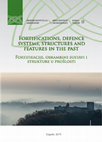
Fortifications, defence systems, structures and features in the past, Zbornik Instituta za arheologiju / Serta Instituti Archaeologici, 2019
This edition brings the conference papers from the 4th International Conference on Mediaeval Arch... more This edition brings the conference papers from the 4th International Conference on Mediaeval Archaeology organised by the Institute of Archaeology in Zagreb in 2017. It is a result of efforts of the medievalists of the Institute of Archaeology to establish continued international gathering of the academic community in Zagreb in order to discuss current archeological topics on mediaeval archeology. The 4th International Scientific Conference on Mediaeval Archaeology Fortifications, defence systems, structures and features in the past, organized by the Institute of Archaeology in cooperation with the Croatian Institute of History, took place from the 7th till the 9th of June 2017 in Zagreb. Our wish was to encourage the researchers to present, through this topic, their knowledge on technical solutions of certain defensive elements of different fortifications, different manifestations and changes in the organization of defensive structures and systems over time, with regard to the causes of those changes and identification of possible patterns of defence systems, structures and features in a certain area, region or in a certain archaeological or historical period. Since the aim of the scientific conference was to perceive the given topic in an interdisciplinary and multidisciplinary manner, we are pleased that in this book, besides the papers dealing with mediaeval fortifications, we have the opportunity to publish 37 papers that study the defence systems in the preceding and following periods (Prehistory, Antiquity, Modern Period) and that archaeological studies are complemented by the studies of historians, art historians and architects as well.

Zbornik Instituta za arheologiju / Serta Instituti Archaeologici, Vol. 10. Sacralization of Landscape and Sacred Places. Proceedings of the 3rd International Scientific Conference of Mediaeval Archaeology of the Institute of Archaeology, 2018
Human settlement of landscape raises the question of marking the landscape with one’s own religio... more Human settlement of landscape raises the question of marking the landscape with one’s own religion. Changes of religious systems or their coexistence documented in the landscape raises further questions, particularly those pertaining to broader socio-cultural phenomena and dynamics. Even if such processes are not documented in written sources, they could often be recognized in toponyms, folklore, archaeological finds and in contemporary religious practices. This publication presents analyses of sacred landscape from the perspective of: archaeology, folklore, ethnology and cultural anthropology, literature, architecture, history, art history, mathematics etc., and at the same time covers the period from prehistory, through antiquity and Slavic period and the Middle Ages to the modern period and contemporary times. In addition to this, it also compares different processes from different regions and times, by and large from Europe.
Zbornik Instituta za arheologiju / Serta Instituti Archaeologici, Vol. 6: Srednjovjekovna naselja u svjetlu arheoloških izvora / Mediaeval Settlements in the Light of Archaeological Sources, Sekelj Ivančan, T., Tkalčec, T., Krznar, S., Belaj, J. (eds.), Zagreb 2017. 411 421 441 459 473 483 499

87 107 123 141 161 203 UVODNA RIJEČ Sustavna arheološka istraživanja srednjovjekovnih i novovjeko... more 87 107 123 141 161 203 UVODNA RIJEČ Sustavna arheološka istraživanja srednjovjekovnih i novovjekovnih groblja na prostoru sjeverne Hrvatske, iako nam mogu pružiti mnoštvo podataka o načinu i kvaliteti života tadašnjih populacija, veoma su rijetka i nedovoljno zastupljena. Ništa bolja situacija nije ni sa znanstvenom objavom provedenih istraživanja te je velika većina objavljena samo u obliku kratkih preliminarnih izvješća. Kako bi stručnoj, ali i široj zainteresiranoj zajednici omogućili uvid u novija istraživanja ili reinterpretacije starih nalaza, Institut za arheologiju organizirao je u lipnju 2014. godine Prvi međunarodni znanstveni skup sredn�ov�e� sredn�ov�e� kovne arheologi�e s temom Grobl�a i pogrebni običa�i u sredn�em i ranom novom vi�eku na prostoru s�everne Hrvatske. Kako se radi o temi koja se ne može u potpunosti obuhvatiti samo arheološkim metodama, cilj nam je bio okupiti veći broj znanstvenika različitih profila (arheologa, antropologa, povjesničara, molekularnih biologa) u multidisciplinarnom pokušaju interpretiranja života i smrti naših predaka. Na skupu je tako sudjelovalo 26 znanstvenika koji su održali 14 predavanja. Skup je održan u prostoru Arheološkog muzeja u Zagrebu čiji djelatnici su nam pružili veliku potporu na čemu im najsrdačnije zahvaljujemo, posebno tadašnjoj ravnateljici Jacquelini Balen. Iste 2014. godine Institut za arheologiju pokreće izdavanje svoje nove edicije pod nazivom Zbornik Instituta za arheologi�u / Serta Instituti Archaeologici radi objavljivanja radova sa skupova u organizaciji Instituta te radova vezanih uz pojedine godišnjice i obljetnice. Prikupljeni i pozitivno ocijenjeni radovi sa skupa Grobl�a i pogrebni običa�i u sredn�em i ranom novom vi�eku na prostoru s�everne Hrvatske objavljuju se unutar 4. knjige Zbornika. Ovdje koristim priliku još jednom zahvaliti svim sudionicima skupa te Ministarstvu znanosti, obrazovanja i športa koje je sufinanciralo izdavanje ovog broja Zbornika Instituta za arheologi�u. Siniša Krznar Groblja i pogrebni običaji u srednjem i ranom novom vijeku na prostoru sjeverne Hrvatske, ZIA Vol. 4, 2016, 7-22 MIRJA JARAK
Papers by Tajana Sekelj Ivančan
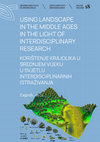
Using landscape in the Middle Ages in the light of interdisciplinary research. Proceedings of the 6th International Scientific Conference on Mediaeval Archaeology of the Institute of Archaeology , ZIA 18, 2021
The paper presents archaeological indicators that testify to the influence of environmental facto... more The paper presents archaeological indicators that testify to the influence of environmental factors on the formation (favourable climate, proximity to water and forests) and reorganization of settlements (due to floods – alluvial deposits), as well as, deposition of colluvial sediments that covered the already abandoned settlement. In it, we tried to connect the facts identified by archaeological research with the findings of interdisciplinary paleoclimatic research and with the research on climate and weather, based on direct and indirect data from written historical sources from the wider Carpathian Basin.
The late medieval archaeologically explored settlement at the position of Buzadovec – Vojvodice (north-western Croatia) is presented. The settlement was formed at the end of the 12th and the beginning of the 13th century in a lowland landscape, not far from the river course. Frequent floods or a major flood in the late 13th or early 14th century caused the position of the older settlement to be abandoned and moved to the slightly elevated terrain. The settlement was continuously inhabited until about the middle of the 15th century. The reason for the cessation of the settlement’s existence has not been determined, but an interesting phenomenon of soil erosion of the neighbouring hill has been recognized, which caused the cultural layers of the abandoned late medieval settlement to be covered with meter-thick deposits of sterile clay.
Avari i Slaveni. Međunarodni zanstveni skup. Dvije strane Pojasnog jezičca. Avari na sjeveru i jugu kaganata; Avars and Slavs. International scientific conference. Two sides of a belt strap end: Avars on the north and the south of the khaganate; Zagreb – Vinkovci 2022; 62-75., 2022
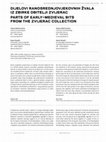
On this occasion, parts are presented of the forged iron bits from the Collection of the Zvijerac... more On this occasion, parts are presented of the forged iron bits from the Collection of the Zvijerac Family, discovered during gravel extraction at the gravel pit called Stara Šoderica to the north of Koprivnica. According to the preserved characteristic sections, particularly the form and decoration of the cheekbars, the form of the loops for attaching the cheek straps and reins, as well as the cross-section of the mouth section, it can be concluded that the parts of both bits belong to the type of simple two-part bits with cheek bars such as were in use during the early medieval period. They are compared with the closest analogous finds of bits from the same period from the region of Slovenia, but also and beyond, and together with earlier published archaeological artefacts from this area they indicate a considerable intensity of settlement in this area along the Drava River during the medieval period.
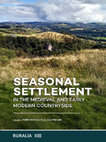
Valent, I., Sekelj Ivančan, T., Šoštarić, R. 2021, In which part of the year did iron smelting occur in the Drava valley?, Ruralia XIII, Seasonal Settlement in the Medieval and Early Modern Countryside, P. Dixon, C. Theune (eds.), Leiden, 253–261. Ruralia XIII, 2021
During extensive field surveys conducted in one part of the Drava river valley, numerous sites of... more During extensive field surveys conducted in one part of the Drava river valley, numerous sites of iron smelting workshops have been identified. For the past 10 years, several of these smelting workshops, dated to Late Antiquity and the early medieval period, have been excavated. It was realised that the furnaces were not isolated in the landscape, but rather that they were located in the close vicinity of settlements, always by a creek, on a small slope, and within a landscape that retains water, which enables the accumulation of bog iron ore in the soil. Due to the fact that the smelting process is highly complicated and requires good preparation as well as good execution, it is believed that it took place during summer and early autumn. The reasons for such a hypothesis lie in the fact that before the smelting process could even begin, certain necessary preparations that included the collection of ore and wood, the drying of logs, and the preparation of charcoal, essential for the process, had to have been completed. Furthermore, archaeo-botanical evidence found within the walls of one furnace, as well as within the settlement, supports the same hypothesis.
Mušič, B., Medarić, I., Valent, I., Sekelj Ivančan, T. 2019, "Geofizička istraživanja srednjovjekovnoga lokaliteta Kalinovac – Hrastova greda 1 / Geophysical research of the medieval site of Kalinovac – Hrastova greda 1", Annales Instituti Archaeologici, Vol. XV, No. 1, Zagreb 2019, 117-122.



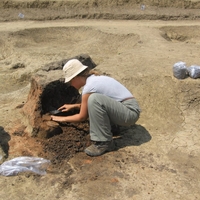
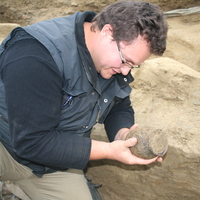




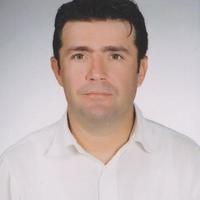
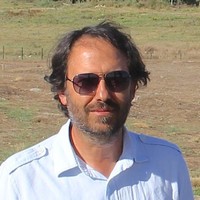
Uploads
Books by Tajana Sekelj Ivančan
području sjeverne Hrvatske. Sama tema, vremenski i geografski okvir koji se u knjizi obrađuje proizlazi iz dugogodišnjih
znanstvenih istraživanja autorā. Tema je razrađena kroz tri glavna poglavlja u kojima se zasebno obrađuje problematika
srednjovjekovnih utvrda, naselja, odnosno groblja. U svakom poglavlju čitatelja se uvodi u problematiku potom se izlaže
tema i donose zasebna zaključna razmatranja. S ciljem da obimna literatura čitateljstvu bude što sistematičnije pristupačna,
ona je okupljena po problematskim cjelinama, odnosno navedena za svaku obrađivanu cjelinu zasebno.
Project presents the results of the scientific project ‘Production of Iron Along the Drava River During Antiquity and Middle Ages: Creation and Transfer of Knowledge, Technology and Commodities - TransFER project (IP – 2016 - 06 - 5047)’ funded by the Croatian Science Foundation. The research presented explores the evidence for and nature of iron production in the lowland area of the central Drava River basin in Croatia during late Antiquity and early Middle Ages, from the turn of the 4th to the early 9th centuries. The wide-ranging methodology of the project features non-destructive archaeological site identification (surface survey and geophysics), archaeological excavation of sites with attested bloomery iron production and processing along with their associated dwelling and settlement structures, as well as experimental archaeology. The record of bloomery iron production and processing is explored via an interdisciplinary approach which examines the technology used as well as the natural resources (bog iron ores, wood and plant remains) exploited in the production process. The results of the research testify to the importance and longevity of iron production in the area of the Drava river valley.
<https://www.archaeopress.com/ArchaeopressShop/Public/displayProductDetail.asp?id=%7bAEBFE202-F7F5-47D6-811C-BCC72C8C07D6%7d>
Papers by Tajana Sekelj Ivančan
The late medieval archaeologically explored settlement at the position of Buzadovec – Vojvodice (north-western Croatia) is presented. The settlement was formed at the end of the 12th and the beginning of the 13th century in a lowland landscape, not far from the river course. Frequent floods or a major flood in the late 13th or early 14th century caused the position of the older settlement to be abandoned and moved to the slightly elevated terrain. The settlement was continuously inhabited until about the middle of the 15th century. The reason for the cessation of the settlement’s existence has not been determined, but an interesting phenomenon of soil erosion of the neighbouring hill has been recognized, which caused the cultural layers of the abandoned late medieval settlement to be covered with meter-thick deposits of sterile clay.
području sjeverne Hrvatske. Sama tema, vremenski i geografski okvir koji se u knjizi obrađuje proizlazi iz dugogodišnjih
znanstvenih istraživanja autorā. Tema je razrađena kroz tri glavna poglavlja u kojima se zasebno obrađuje problematika
srednjovjekovnih utvrda, naselja, odnosno groblja. U svakom poglavlju čitatelja se uvodi u problematiku potom se izlaže
tema i donose zasebna zaključna razmatranja. S ciljem da obimna literatura čitateljstvu bude što sistematičnije pristupačna,
ona je okupljena po problematskim cjelinama, odnosno navedena za svaku obrađivanu cjelinu zasebno.
Project presents the results of the scientific project ‘Production of Iron Along the Drava River During Antiquity and Middle Ages: Creation and Transfer of Knowledge, Technology and Commodities - TransFER project (IP – 2016 - 06 - 5047)’ funded by the Croatian Science Foundation. The research presented explores the evidence for and nature of iron production in the lowland area of the central Drava River basin in Croatia during late Antiquity and early Middle Ages, from the turn of the 4th to the early 9th centuries. The wide-ranging methodology of the project features non-destructive archaeological site identification (surface survey and geophysics), archaeological excavation of sites with attested bloomery iron production and processing along with their associated dwelling and settlement structures, as well as experimental archaeology. The record of bloomery iron production and processing is explored via an interdisciplinary approach which examines the technology used as well as the natural resources (bog iron ores, wood and plant remains) exploited in the production process. The results of the research testify to the importance and longevity of iron production in the area of the Drava river valley.
<https://www.archaeopress.com/ArchaeopressShop/Public/displayProductDetail.asp?id=%7bAEBFE202-F7F5-47D6-811C-BCC72C8C07D6%7d>
The late medieval archaeologically explored settlement at the position of Buzadovec – Vojvodice (north-western Croatia) is presented. The settlement was formed at the end of the 12th and the beginning of the 13th century in a lowland landscape, not far from the river course. Frequent floods or a major flood in the late 13th or early 14th century caused the position of the older settlement to be abandoned and moved to the slightly elevated terrain. The settlement was continuously inhabited until about the middle of the 15th century. The reason for the cessation of the settlement’s existence has not been determined, but an interesting phenomenon of soil erosion of the neighbouring hill has been recognized, which caused the cultural layers of the abandoned late medieval settlement to be covered with meter-thick deposits of sterile clay.
Provedena analiza biljnih ostataka pružila je važne informacije o vegetaciji koja je uspijevala u blizini lokaliteta Virje-Volarski breg tijekom njegova zaposjedanja, odnosno tijekom latena (mlađega željeznog doba), kasne antike i ranoga srednjeg vijeka. Biljni pokrov sagledan je iz arheološke perspektive, prvenstveno s obzirom na okolnost da je lokalitet korišten za različitu funkciju u različito vrijeme. Za kasnu antiku i rani srednji vijek dokazana je talionička djelatnost koja je zahtijevala velike količine goriva, dok u latenu takva djelatnost na istraženoj površini nije zabilježena. Istraženi latenski objekti naseobinskog su karaktera kao i ranosrednjovjekovni objekti. Zamijećene razlike u korištenju različite vrste drva povezane su s različitim vremenom njegova iskorištavanja, uvjetovane drugačijim navikama stanovništva s jedne strane, ali i mogućim različitim klimatskim uvjetima s druge strane, te korištenju različite vrste drva za različitu namjenu.
povezanih s proizvodnjom i obradom željeza za potrebe znanstveno-istraživačkog projekta TransFER. No, osim položaja na kojima su po površini oranica pronađeni komadi kovačke ili talioničke zgure, tijekom više obilazaka evidentirano je nekoliko novih lokaliteta na kojima su nalazi koji ukazuju na kovačku ili talioničku djelatnost izostali, ali su prikupljeni brojni ulomci
keramičkih posuda koji ukazuju na naseljenost lokaliteta u raznim razdobljima prapovijesti, antike i srednjega vijeka. U radu se donosi pregled novopronađenih arheoloških nalazišta evidentiranih na području koprivničke i đurđevačke Podravine.
locations were researched in the surroundings of Virje (Croatia) in the
basin of the river Drava, on which the primary processing of iron was
confirmed during six archaeological campaigns. This tedious process of
iron ore smelting took place on these locations during the late Antiquity
and the early Middle Ages, as was demonstrated by the results of the radiocarbon
analysis (C14) taken from furnaces examined and accompanying
archaeological material. Such sites are extremely rare in Northern
Croatia.
Virje is located in the area which, throughout history, was rich in resources
necessary for the production of iron (wood, clay, water), but there
is the question of the sources of raw material, i.e. iron ore. Starting from
the basic assumption that raw materials come from surrounding areas,
an analysis of the concentration of iron in the surrounding sediments
was conducted. The results have revealed that some of the samples show
extremely low values, however, one part of it contains about 20% of iron
in the soil. This leads us to the conclusion that the lowland, marshy landscape
along the river Drava, where groundwater is high and where water
is retained longer during colder and more humid periods, is a perfect environment
for the natural settling of iron ore necessary for the process of
smelting. Conducted studies have shown that the positioning of smelting
activities in the vicinity of Virje is conditioned by natural resources in the
Drava River basin, where smaller local deposits of iron can be found.
"Sacralisation of Landscape and Sacred Places"
which will be held on the 2nd and 3rd June 2016, at the Archaeological Museum in Zagreb, 19 Zrinski square, Zagreb, Croatia.
"Ceramics, People and Places - The Significance of Ceramics for the Study of Social Relations in the Middle Ages",
which will be held on the 6th and 7th of June 2024, at the conference hall of the Institute of Archaeology, Ulica kralja Zvonimira 6, Zagreb.
Book of abstracts give all the informations on the conference program and the abstracts of 74 lectures and 14 posters.
There are 123 participants from 16 countries at the conference.
The conference is organised by Institute of Archaeology (Zagreb) in co-organisation with the Croatian Institute of History.
The place of the Conference is in the Croatian Institute of History (Opatička 10, Zagreb).
Partners of the Conference are Archaeological museum in Zagreb and Zagreb City Museum.
2nd International Conference of Mediaeval Archaeology
Zagreb, 2.-3. 6. 2015.
Sacralisation of Landscape and Sacred Places
which will be held on the 2nd and 3rd June 2016, at the Archaeological Museum in Zagreb, 19 Zrinski square, Zagreb, Croatia.
Human settlement of landscape raises also the question of marking the landscape with one’s own religion. A similar happens when religious systems are changed. In addition, we often witness preserved continuity of sacred places. Such procedures are often undocumented, but their traces can still be found in toponyms, folklore, archaeological finds and in contemporary religious practices. The Conference will gather about 80 participants from Croatia and abroad They will approach the conference theme from different research perspectives and disciplines.
Introductory plenary lecture "Sacral spatial arrangement of landscape" will be given by prof. dddr. Andrej Pleterski, Research Advisor, Research Centre of the Slovenian Academy of Sciences and Arts, Ljubljana, Slovenia.
The Conference consists of the following sessions:
- Human and sacred landscape: paradigms
- Traces of sacred sites: prehistory
- Myth in landscape
- Sacred place - the arena of religious discourses
- Social realities in the sacralisation of space
- Narratives and practices in the sacralisation of space
- Reading of holy places and sites in Islamic tradition
- Traces of sacred sites: antiquity
- (De)Sacralisations: spatial biographies
- Christian spatial symbolisation
The Conference programme and the book of abstracts are attached in the pdf file.
Feel free to join us at the Conference, you are kindly invited!
With kind regards,
Dr Juraj Belaj, senior research associate
(on behalf of the organization committee)
TransFER - Iron production along the Drava River in the Roman period and the Middle Ages: Creation and transfer of knowledge, technologies and goods (IP-2016-06-5047)
At the presentation will be presented the project objectives, the project team and the research that will be carried out as well as expected results.
The project will introduce by
Tajana Sekelj Ivančan, PhD, Principal investigator, Institute of Archaeology, Zagreb, Croatia,
Branko Mušič, PhD, University of Ljubljana, Department of Archaeology, Slovenia,
Sibila Borojević Šoštarić, PhD; Faculty of Mining, Geology and Petroleum Engineering, University of Zagreb, Croatia,
Robert Čimin, MA, Municipal Museum of Koprivnica, Croatia
The presentation will be held on Thursday, 30th of March 2017 at 12 AM in the Library of the Institute of Archaeology, Lj. Gaja 32, Zagreb.
We kindly invite You to the 5th Geoarchaeological conference: LATE ANTIQUITY AND MIGRATION PERIOD IN THE LIGHT OF GEOARCHAEOLOGICAL RECORDS FROM THE EASTERN MEDITERRANEAN, EASTERN ADRIATIC AND ADJACENT REGIONS - organized by the Institute of Archaeology, Cardinal Stefan Wyszynski University in Warsaw, the Institute of Archaeology in Zagreb and Faculty of Humanities and Social Sciences, University of Zagreb.
The Conference will be held at the Library of the Faculty of Humanities and Social Sciences, Zagreb 23rd-24th of October 2018.
Requests for detailed information please contact Dr Katarina Botic: kbotic@iarh.hr. We are looking forward to Your participation.
Dr hab. Fabian Welc Institute of Archaeology, Cardinal Stefan Wyszynski University in Warsaw, Poland (President of the organizing committee)
Dr. Katarina Botić Institute of Archaeology, Zagreb, Croatia (Vice-president of the organizing committee)
Prof. Marcel Burić Department of Archaeology, Faculty of Humanities and Social Sciences, University of Zagreb, Croatia (Member of the organizing committee)
We are pleased to invite you to the7th International Scientific Conference on Mediaeval Archaeology of the Institute of Archaeology " Secrets of iron - from raw material to an iron object“
The conference will be held in Zagreb, Croatia, 3 - 6 June 2020.
Theme of the Conference includes all archaeological periods. Since the character of this subject transcends the traditional boundaries of the archaeological discipline, so we are looking forward to a multidisciplinary encounter of different ideas, approaches, methods, results and interpretations.
- the official languages of the conference are Croatian and English,
- if you plan to deliver your presentation in Croatian, we kindly ask you to submit the title and summary of the presentation in both Croatian and English,
- presentations are limited to 20 minutes.
Please see the attached file for more details.
//
Poštovane kolegice i kolege,
zadovoljstvo nam je pozvati Vas na 7. međunarodni znanstveni skup srednjovjekovne arheologije Instituta za arheologiju „Tajne željeza - od sirovine do željeznog predmeta / Secrets of iron - from raw material to an iron object“
Skup će se održati od 3. do 6. lipnja 2020. u Zagrebu.
Tema skupa obuhvaća sva arheološka razdoblja i nadilazi okvir arheološke discipline te stoga priželjkujemo multidisciplinarni susret različitih ideja, pristupa, metoda, rezultata i interpretacija.
- službeni jezici skupa su hrvatski i engleski,
- ako planirate izlagati na hrvatskom jeziku, molimo da naslov i sažetak izlaganja pošaljete na hrvatskom i engleskom jeziku,
- predviđeno trajanje izlaganja je 20 minuta.
Za više detalja pogledajte priložene dokumente.
We kindly invite you to take part in the 9th International Scientific Conference on Mediaeval Archaeology of the Institute of Archaeology entitled "Ceramics, People and places: the Significance of Ceramics for the Study of Social Relations in the Middle Ages", which will be held in Zagreb 6—7 June 2024.
Please find more details in attached documents.